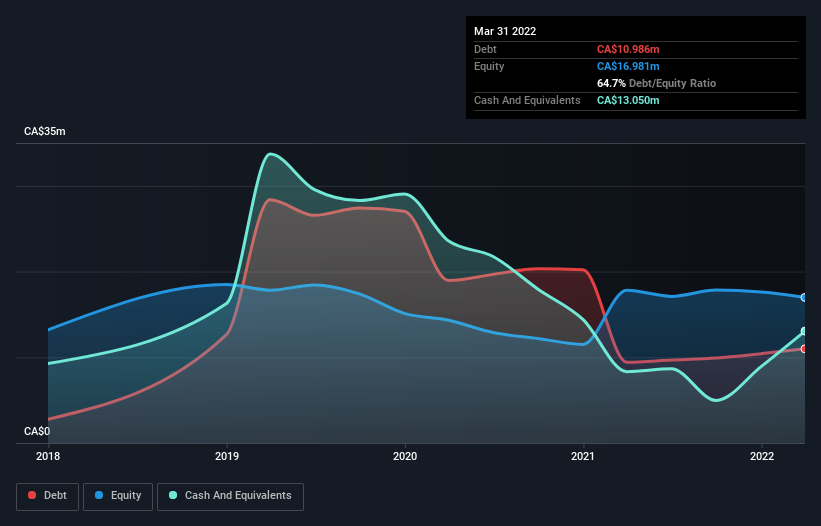These 4 Measures Indicate That Mene (CVE:MENE) Is Using Debt Reasonably Well
Legendary fund manager Li Lu (who Charlie Munger backed) once said, 'The biggest investment risk is not the volatility of prices, but whether you will suffer a permanent loss of capital.' So it might be obvious that you need to consider debt, when you think about how risky any given stock is, because too much debt can sink a company. As with many other companies Mene Inc. (CVE:MENE) makes use of debt. But is this debt a concern to shareholders?
Why Does Debt Bring Risk?
Debt and other liabilities become risky for a business when it cannot easily fulfill those obligations, either with free cash flow or by raising capital at an attractive price. Part and parcel of capitalism is the process of 'creative destruction' where failed businesses are mercilessly liquidated by their bankers. However, a more frequent (but still costly) occurrence is where a company must issue shares at bargain-basement prices, permanently diluting shareholders, just to shore up its balance sheet. Of course, the upside of debt is that it often represents cheap capital, especially when it replaces dilution in a company with the ability to reinvest at high rates of return. The first thing to do when considering how much debt a business uses is to look at its cash and debt together.
Check out our latest analysis for Mene
What Is Mene's Debt?
As you can see below, at the end of March 2022, Mene had CA$11.0m of debt, up from CA$9.42m a year ago. Click the image for more detail. However, its balance sheet shows it holds CA$13.0m in cash, so it actually has CA$2.06m net cash.
How Healthy Is Mene's Balance Sheet?
Zooming in on the latest balance sheet data, we can see that Mene had liabilities of CA$12.9m due within 12 months and no liabilities due beyond that. Offsetting these obligations, it had cash of CA$13.0m as well as receivables valued at CA$264.5k due within 12 months. So it actually has CA$431.8k more liquid assets than total liabilities.
Having regard to Mene's size, it seems that its liquid assets are well balanced with its total liabilities. So while it's hard to imagine that the CA$134.3m company is struggling for cash, we still think it's worth monitoring its balance sheet. Succinctly put, Mene boasts net cash, so it's fair to say it does not have a heavy debt load!
We also note that Mene improved its EBIT from a last year's loss to a positive CA$409k. The balance sheet is clearly the area to focus on when you are analysing debt. But you can't view debt in total isolation; since Mene will need earnings to service that debt. So if you're keen to discover more about its earnings, it might be worth checking out this graph of its long term earnings trend.
Finally, while the tax-man may adore accounting profits, lenders only accept cold hard cash. Mene may have net cash on the balance sheet, but it is still interesting to look at how well the business converts its earnings before interest and tax (EBIT) to free cash flow, because that will influence both its need for, and its capacity to manage debt. Over the last year, Mene actually produced more free cash flow than EBIT. That sort of strong cash generation warms our hearts like a puppy in a bumblebee suit.
Summing up
While we empathize with investors who find debt concerning, you should keep in mind that Mene has net cash of CA$2.06m, as well as more liquid assets than liabilities. And it impressed us with free cash flow of CA$4.3m, being 1,062% of its EBIT. So we are not troubled with Mene's debt use. The balance sheet is clearly the area to focus on when you are analysing debt. But ultimately, every company can contain risks that exist outside of the balance sheet. Case in point: We've spotted 1 warning sign for Mene you should be aware of.
Of course, if you're the type of investor who prefers buying stocks without the burden of debt, then don't hesitate to discover our exclusive list of net cash growth stocks, today.
Have feedback on this article? Concerned about the content? Get in touch with us directly. Alternatively, email editorial-team (at) simplywallst.com.
This article by Simply Wall St is general in nature. We provide commentary based on historical data and analyst forecasts only using an unbiased methodology and our articles are not intended to be financial advice. It does not constitute a recommendation to buy or sell any stock, and does not take account of your objectives, or your financial situation. We aim to bring you long-term focused analysis driven by fundamental data. Note that our analysis may not factor in the latest price-sensitive company announcements or qualitative material. Simply Wall St has no position in any stocks mentioned.

